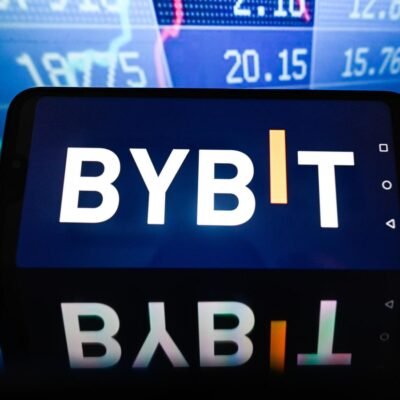This month’s stark stock market swing serves as an indicator of things soon to come, warns one veteran hedge fund operator.
Mark Spitznagel, president and chief investment officer of Universa Investments, made the prediction in an interview with Fortune, almost two weeks after the scare.
At the time, markets from Japan to the US fell without warning, following a weak jobs report surging volatility amid conflict in the Middle East.
In the wake of the dip, markets have since rebounded – but Spitznagel on Sunday insisted that may be misleading.
The billionaire investor said we’re instead on the verge of the biggest stock market bubbles in history, which inevitably will end with a burst as it did in 2008. Back then, mortgages unloaded to high-risk borrowers resulted in a period of turmoil, following a euphoric bull run.

Mark Spitznagel, the 53-year-old president and chief investment officer of Universa Investments, made the prediction in an interview with Fortune, almost two weeks after the turmoil
‘These whips are the market process,’ the 53-year-old said of the more recent unrest, as the S&P 500 on Sunday stood about 5 percent from its August 5 low.
‘This is the market zigging in order to zag.’
Of the panic seen from investors days before, the hedge fund manager declared, ‘It was amateur hour. I have never seen anything like that in my career.’
He went on to explain that while another bull run is in the cards most investors will not be prepared for what comes next over the course of the next several months.
‘This is a stark red flag, it’s a stark warning sign,’ he said, forecasting financial ruin.’
‘[It’s] a great comparison to 2007.’
Citing the weight of the Fed’s repeated rate hikes and the fact that interest rates have been near zero for over a decade following the financial crisis created by the reckless lending, he added, ‘But I think we’re going to see a compressed path.’
Unlike the buildup to the Great Recession, which took the better part of a year, he said that this time around, ‘I don’t think we’ve got a year of this.’
As for his rationale, he explained, ‘[B]ecause the connectivity is greater…the fragility is greater.’

At the time, markets from Japan to the US fell without warning, following a weak jobs report surging volatility amid conflict in the Middle East
The tighter timeframe, he said, stems in large part from the Fed’s recent rate hikes, and will cause an even more abrupt turnaround than the 2008 market blowup and others before it.
Explaining how Americans are essentially in the midst of a global economy that’s more interwoven than ever, he said the Fed’s policies move markets worldwide.
This is what caused Japan’s Nikkei 225 worst day since 1987, when it fell more than 12 percents, and South Korea’s KOSPI simultaneous reduction of eight percent.
A mid-day halt to trading ensued, followed by a sell-off on the global scale.
‘Dips are the price of stock market gains,’ Spitznagel said of the scare.
‘You’ve got to be able to pay that price. The problem is, the big ones. They’re too destructive of a price,’ he continued. ‘That’s where we could be headed.’
He went on to disclaim how the key word in that warning is ‘could’, advising onlookers to not take unnecessary risks for betting big against his predicted bubble.
‘I think if anybody shorts the market or is too under invested relative to their temperament, they’re going to get squeezed in at a euphoric height that is probably still coming in the months ahead,’ Spitznagel said.
Instead, he urged investors to be patient, by first investing in basic S&P 500 index funds, and to also maintain a safety net as to not be forced to make a sudden sale at any given moment.

Unlike the buildup to the Great Recession, which took the better part of a year, the hedge funder said that this time around, ‘I don’t think we’ve got a year of this’
The biggest sin in trading, he said, is to sell near a market low or buy near a peak – meaning one must think ahead.
‘I think people just kind of need to have this come-to-Jesus moment,’ he concluded by saying.
‘Close your eyes, think about a world where the market is down 50 to 75% and then think about opening your portfolio.
‘Are you going to do something crazy? And now, think about it [being] up 20%, and open your portfolio. Are you going to do something crazy?’
He went on to disclaim how the key word in that warning is ‘could’, advising onlookers to not take unnecessary risks for betting big against his predicted bubble.
‘I think if anybody shorts the market or is too under invested relative to their temperament, they’re going to get squeezed in at a euphoric height that is probably still coming in the months ahead,’ Spitznagel said.
Instead, he urged investors to be patient, by first investing in basic S&P 500 index funds, and to also maintain a safety net as to not be forced to make a sudden sale at any given moment.

An economist who accurately predicted the 2008 recession, David Rosenberg, also had a similar forecast last month, after the the release of June’s nonfarm payrolls report
He went on to point to what he painted as a weak breadth beneath the broader stock market, evident by a few stocks driving the bulk of returns.
‘Nvidia alone accounted for nearly one-third of the S&P 500’s total return in the first half of this year,’ he explained, citing the tech stock as an example.
‘Tack on Microsoft, Amazon, Meta and Eli Lilly, and 55 percent of the market’s return came from just those five stocks.
‘That is epic. So is the fact that 40 percent of the S&P 500 constituents are down for the year.’
Another example of poor performance outside of such stocks was a 4.3 percent decline in the small and mid-cap Russell 2500 index in Q2, he said – masked by the S&P 500’s simultaneous rise of 4.3 percent.
He said such decreases show a need for the Fed to act urgently, as the labor market continues to weaken. He added how that is already happening, before offering three self-professed ‘indicators’ meant to prove his point.
Back in 1973, the statistic took an eerily similar dip before declining steadily in the years thereafter.
This period would be come to known as The Recession – and Recovery – of 1973-1976, when the unemployment rate reached a postwar high of 8.5 percent at the business cycle trough (March 1975) and did not peak until May 1975, when it hit 9.0 percent.

The fellow hedge fund operator based his prediction on last month’s numbers from the Bureau of Labor Statistics’ Household Survey – a key recession indicator that may have influenced this month’s sell off
A few years later, the same would occur again – just before the 1980 recession and the 1981-1982 recession the year after.
The same more than 1 percent dip happened again in 1989 before the early 1990s recession, before another in 2001 to mark the recession of the early 2000s.
Like clockwork, the same phenomenon would occur again at the start of 2008 to mark the Great Recession, bringing an end to a period of recovery and expansion known as the Great Moderation.
It was the largest economic downturn since the Great Depression, it was predated by an approximate 1 percent from in full-time employment from 2007 to 2008 – which went on to fall off a cliff by a further six percent the following year.
Rosenberg said something similar could be in store this year, based on the almost identical-dip seen the year prior.
Another recessionary sign seen on the household survey, he said, is that overall employment growth is about to dip negative year-over-year – the first time since the pandemic seen during the recession and the Great Recession before that.

Spitznagel, meanwhile, has said for years that the Fed has essentially created the perfect conditions for the greatest credit bubble in history, after keeping interests low since the Great Recession.. This, he said, has left the economy in a fragile state, ripe for a historic downturn
These weak job numbers have been credited for the trying day for investors worldwide that would occur just a few weeks later, as the US economy continues to try to correct itself.
Spitznagel, meanwhile, has said for years that the Fed has essentially created the perfect conditions for the greatest credit bubble in history, after keeping interests low since the Great Recession.
This, he said, has left the economy in a fragile state, ripe for a historic sell-off.
The looming presidential election is also making investors wary over a second Joe Biden term in the White House, due to his proposed hike on capital gains tax.
The President has outlined plans to increase the top marginal rate on long-term capital gains and qualified dividends from 23.8 percent to 44.6 percent.
Ted Jenkin, CEO of oXYGen Financial, recently warned that the planned increases will go into effect at the same time critical tax cuts brought in by Trump will also expire. Jenkin explained those two factors would ‘crush’ the economy as Americans race to sell up their assets in advance.
High tax states such as New York, California and Hawaii would be hit especially hard.





